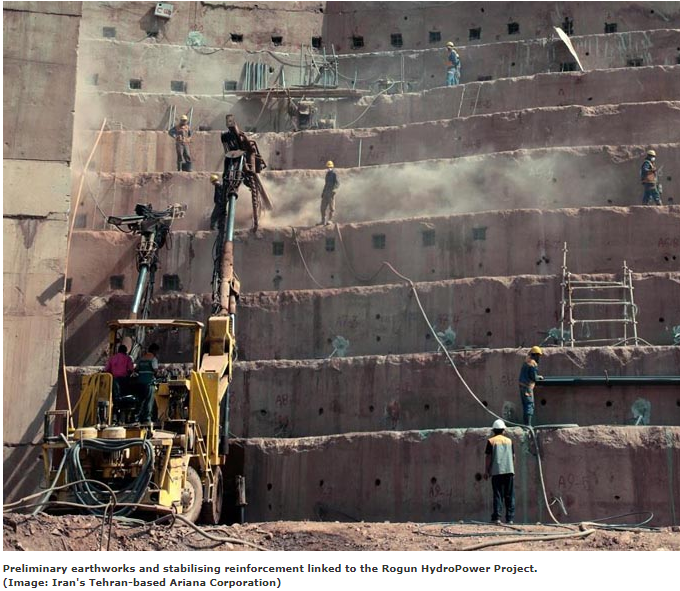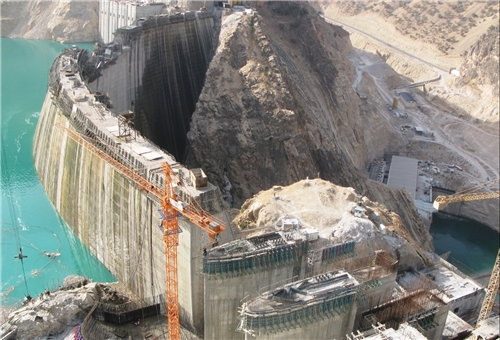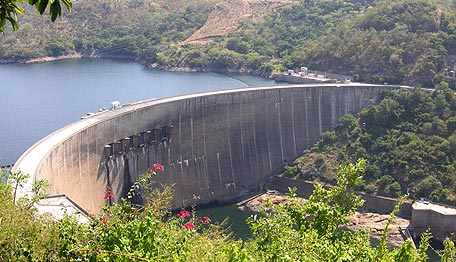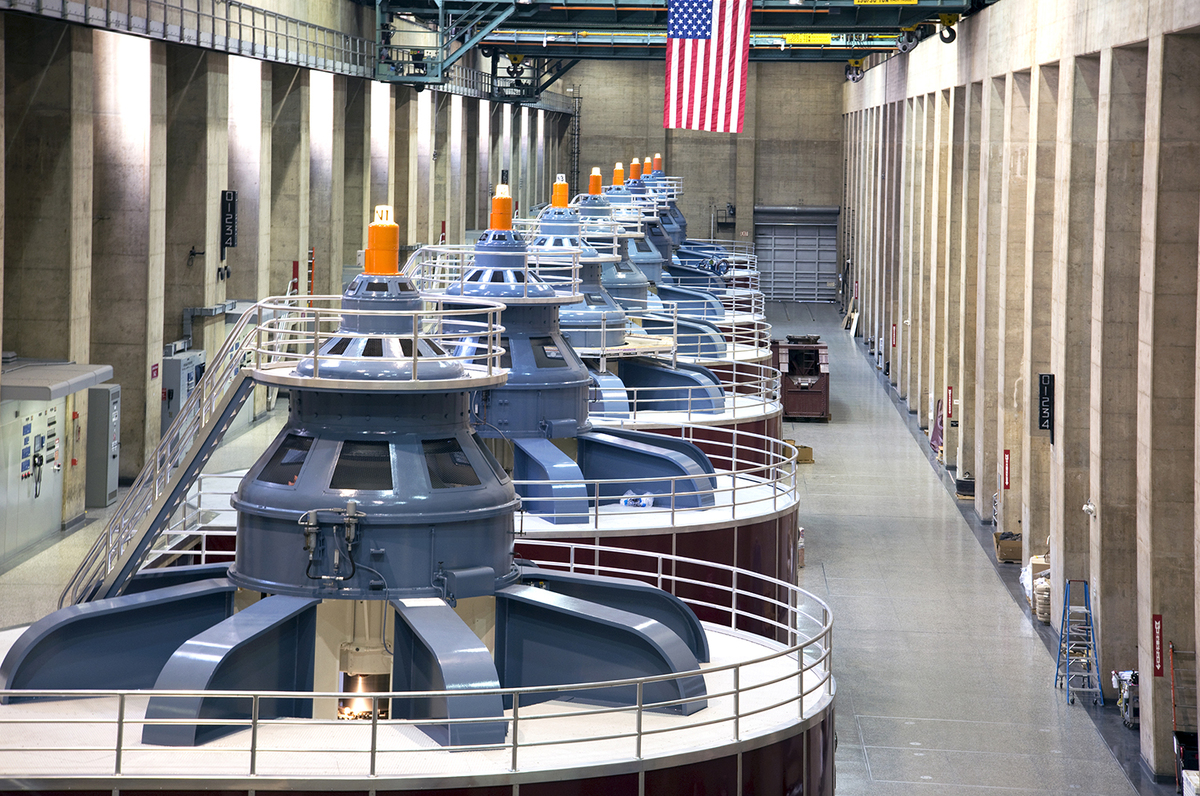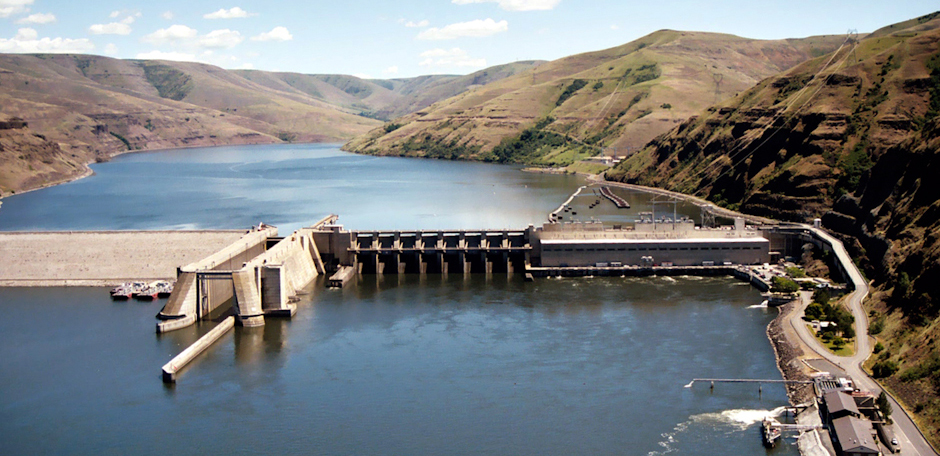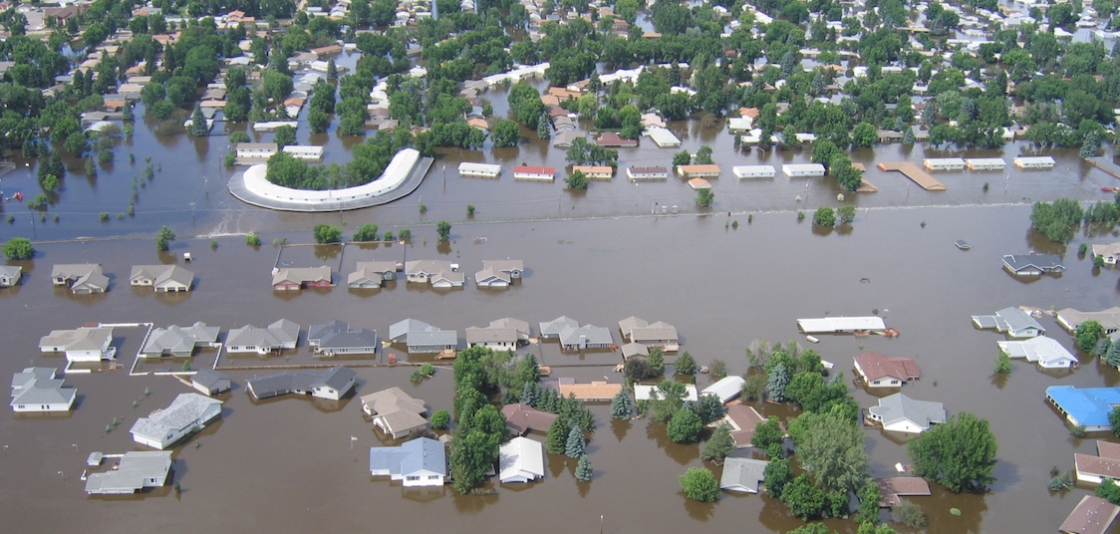8.0 MODULE OVERVIEW AND OBJECTIVES
Welcome to Module 8
This unit includes the following three modules:
- 8.1 Introduction to dams and reservoirs
- 8.2 Benefits of dams
- 8.3 Impacts of dams and reservoirs
Module objectives:
By the end of this module you should be able to
- Recognize that although humans have been constructing dams for millennia, hydroelectric dams were not used until the late 1800’s and intensive building of large dams did not begin until the 1900’s (Module 8.1)
- Recognize that dam construction in the United States peaked in the 1960s and has declined ever since, with dam removal now outpacing dam construction (Module 8.1)
- Recognize the approximate number of large and small dams (orders of magnitude) in the world (Module 8.1)
- Discuss how dams help societies secure water supplies and overcome seasonal and climatic variability in water availability (Module 8.2)
- List the most common purposes of dams (Module 8.2)
- Recognize that nearly 50% of the world’s dams are used for irrigation (Module 8.2)
- Recognize that about 24% of the world’s electricity comes from hydropower (Module 8.2)
- Discuss the environmental and social consequences of large dams (Module 8.3)
- Summarize the conclusions of the United Nations Word Commission on Dams (Module 8.3)
- Discuss why many developing countries are actively building large dams (Module 8.3)
- List the Chinese government’s arguments in favor of building large dams (Module 8.3)
- Explain why it is not true that hydropower is an “emissions free” source of energy (Module 8.3)
Module Assignments
- Module 8 Quiz
- Module 7 & 8 Current Events
8.1 INTRODUCTION TO DAMS AND RESERVOIRS
First, let’s cover a little bit of history…

1. Dam building has taken place for millennia.
- Remnants of ancient dams dating as far back as 3000 b.c. have been found in the Middle East.
- There is evidence that widespread use of dams to create reservoirs for agricultural irrigation began about 2000 b.c.
2. One of the main motivations for building dams is to generate hydroelectricity. The first hydroelectric power plant was built in the 1880’s on the Fox River in Wisconsin.
- By 1920, just 40 years after the first hydroelectric power plant was built, the U.S. was producing 25% of its electricity using hydropower.
3. Beginning with the construction of the Hoover dam in the 1930’s, the Golden Age of dam building in the United States continued for approximately 50 years.
- This Golden Age of dam construction peaked in the 1960s, a decade during which dam completion in the U.S. averaged more than 5 dams per day! (See graph under bullet #4 below.)
4. Beginning in the 1980’s dam construction in the U.S. slowed tremendously due to a variety of reasons.
- There were few places suitable for dams that were left to build dams on.
- Public awareness of the environmental and social consequences of dam building increased.
- Most dams were constructed to have a 50 – 100 year life span. By the 1980’s the dams built during the first part of the Golden Age of dam construction were beginning to show their age and need maintenance and repairs. In many cases, particularly for small dams, removal is easier and much less expensive than repair or maintenance. For the past several years, dam removal has outpaced dam construction in the United States.
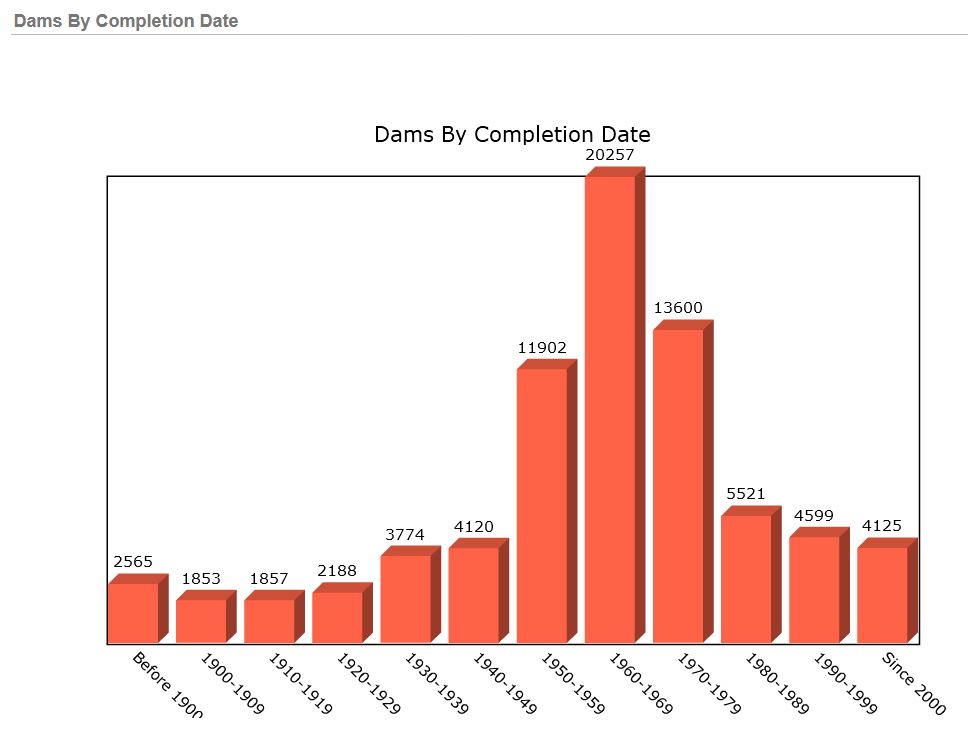
Some dam facts…
1. There are currently about 59,071 dams listed in the World Register of Dams. The Register generally includes dams that are at least 15 m (~50 ft) high.
- Although there is no universal agreement on the distinction between small and large dam, dams that are at least 15 m high are often considered to be large dams. Dams that are between 5 m and 15 m ( ~16-50 ft) high are typically considered to be small dams. The International Commission on Large Dams considers dams with heights less than 15 m but that hold at least 3 million cubic meters of water as large dams.
- There are millions of small dams that are not listed in the Register. Notice the astonishing number of small dams (green and yellow dots) in the U.S. alone in the following figure. (Note the data in the figure are from the 2016 National Inventory of Dams (NID)).
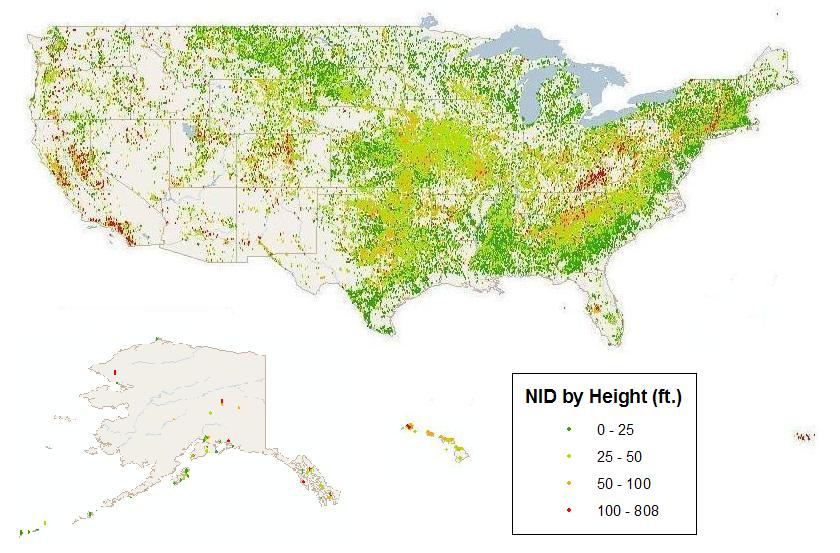
- Below is the number of dams registered with the International Commission on Large Dams by country for the 10 countries with the most registered dams.
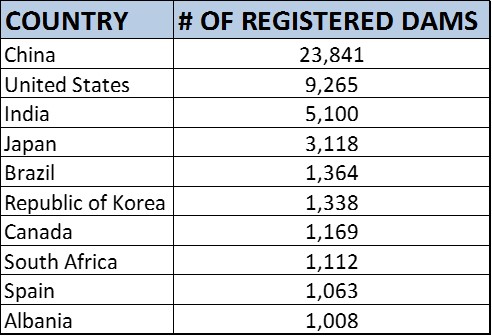
- When completed, the Burgon dam in Tajikstan will be the world’s highest dam at 335 m.
- The Bakhtiari dam in Iran will be the world’s second highest dam at 315 m when completed.
- The Jinping dam in China is the tallest completed dam at 305 m.
- The dam with the largest capacity in the world is the Kariba dam in Zimbabwe. Its reservoir capacity is more than 1.8 x 10^11 cubic meters.
8.2 BENEFITS OF DAMS
Dams provide a wide variety of services for society. Read through the following information that was pulled from a website hosted by the International Commission on Large Dams. As you read through the information, pay particular attention to:
- The role that dams and reservoirs can play in securing water supplies and overcome seasonal and climatic variations in water availability
- The purposes of dams (You should be able to list these)
- Globally, almost 50% of dams are for irrigation
- Hydropower provides about 24% of the world’s electricity
Role of Dams
Taken from: http://www.icold-cigb.net/GB/dams/role_of_dams.asp, last accessed 7/8/18.
Why do we need dams?
In ancient times, dams were built for the single purpose of water supply or irrigation. As civilizations developed, there was a greater need for water supply, irrigation, flood control, navigation, water quality, sediment control and energy. Therefore, dams are constructed for a specific purpose such as water supply, flood control, irrigation, navigation, sedimentation control, and hydropower. A dam is the cornerstone in the development and management of water resources development of a river basin. The multipurpose dam is a very important project for developing countries, because the population receives domestic and economic benefits from a single investment.
Demand for water is steadily increasing throughout the world. There is no life on earth without water, our most important resource apart from air and land. During the past three centuries, the amount of water withdrawn from freshwater resources has increased by a factor of 35, world population by a factor of 8. With the present world population of 5.6 billion still growing at a rate of about 90 million per year, and with their legitimate expectations of higher standards of living, global water demand is expected to rise by a further 2-3 percent annually in the decades ahead.
But freshwater resources are limited and unevenly distributed. In the high-consumption countries with rich resources and a highly developed technical infrastructure, the many ways of conserving, recycling and re-using water may more or less suffice to curb further growth in supply. In many other regions, however, water availability is critical to any further development above the present unsatisfactorily low level, and even to the mere survival of existing communities or to meet the continuously growing demand originating from the rapid increase of their population. In these regions man cannot forego the contribution to be made by dams and reservoirs to the harnessing of water resources.
Seasonal variations and climatic irregularities in flow impede the efficient use of river runoff, with flooding and drought causing problems of catastrophic proportions. For almost 5 000 years dams have served to ensure an adequate supply of water by storing water in times of surplus and releasing it in times of scarcity, thus also preventing or mitigating floods
With their present aggregate storage capacity of about 6 000 km3, dams clearly make a significant contribution to the efficient management of finite water resources that are unevenly distributed and subject to large seasonal fluctuations.
The purposes of dams:
Most of the dams are single-purpose dams, but there is now a growing number of multipurpose dams. Using the most recent publication of the World Register of Dams, irrigation is by far the most common purpose of dams. Among the single purpose dams, 48 % are for irrigation, 17% for hydropower (production of electricity), 13% for water supply , 10% for flood control, 5% for recreation and less than 1% for navigation and fish farming.
Irrigation:
Presently, irrigated land covers about 277 million hectares i.e. about 18% of world’s arable land but is responsible for around 40% of crop output and employs nearly 30% of population spread over rural areas. With the large population growth expected for the next decades, irrigation must be expanded to increase the food capacity production. It is estimated that 80% of additional food production by the year 2025 will need to come from irrigated land. Even with the widespread measures to conserve water by improvements in irrigation technology, the construction of more reservoir projects will be required.
Hydropower:
Hydroelectric power plants generally range in size from several hundred kilowatts to several hundred megawatts, but a few enormous plants have capacities near 10,000 megawatts in order to supply electricity to millions of people. World hydroelectric power plants have a combined capacity of 675,000 megawatts that produces over 2.3 trillion kilowatt-hours of electricity each year; supplying 24 percent of the world’s electricity.
In many countries, hydroelectric power provides nearly all of the electrical power. In 1998, the hydroelectric plants of Norway and the Democratic Republic of the Congo (formerly Zaire) provided 99 percent of each country’s power; and hydroelectric plants in Brazil provided 91 percent of total used electricity.
Electricity generated from dams is by very far the largest renewable energy source in the world. More than 90% of the world’s renewable electricity comes from dams. Hydropower also offers unique possibilities to manage the power network by its ability to quickly respond to peak demands. Pumping-storage plants, using power produced during the night, while the demand is low, is used to pump water up to the higher reservoir. That water is then used during the peak demand period to produce electricity. This system today constitute the only economic mass storage available for electricity.
Water supply for domestic and industrial use:
It has been stressed how essential water is for our civilization. It is important to remember that of the total rainfall falling on the earth, most falls on the sea and a large portion of that which falls on earth ends up as runoff. Only 2% of the total is infiltrated to replenish the groundwater. Properly planned, designed and constructed and maintained dams to store water contribute significantly toward fulfilling our water supply requirements. To accommodate the variations in the hydrologic cycle, dams and reservoirs are needed to store water and then provide more consistent supplies during shortages.
Inland navigation:
Natural river conditions, such as changes in the flow rate and river level, ice and changing river channels due to erosion and sedimentation, create major problems and obstacles for inland navigation. The advantages of inland navigation, however, when compared with highway and rail are the large load carrying capacity of each barge, the ability to handle cargo with large-dimensions and fuel savings. Enhanced inland navigation is a result of comprehensive basin planning and development utilizing dams, locks and reservoirs which are regulated to provide a vital role in realizing regional and national economic benefits. In addition to the economic benefits, a river that has been developed with dams and reservoirs for navigation may also provide additional benefits of flood control, reduced erosion, stabilized groundwater levels throughout the system and recreation.
Flood control:
Dams and reservoirs can be effectively used to regulate river levels and flooding downstream of the dam by temporarily storing the flood volume and releasing it later. The most effective method of flood control is accomplished by an integrated water management plan for regulating the storage and discharges of each of the main dams located in a river basin. Each dam is operated by a specific water control plan for routing floods through the basin without damage. This means lowering of the reservoir level to create more storage before the rainy season. This strategy eliminates flooding. The number of dams and their water control management plans are established by comprehensive planning for economic development and with public involvement. Flood control is a significant purpose for many of the existing dams and continues as a main purpose for some of the major dams of the world currently under construction.

8.3 IMPACTS OF DAMS AND RESERVOIRS
As noted in Section 8.1, dam building in the United States (and also in Europe) has declined significantly since about 1980. This decline is due in large part to society’s growing recognition of the negative environmental and social consequences of dam building. Read through the following information and examples some of the negative impacts of dams.
1. Ecosystem degradation:
- create barriers to fish migration
- change the water temperature and depth
- alter the water chemistry
- flood riparian areas
- change downstream flooding regimes
When fishermen fought over Susquehanna shad
Lancaster Online, The Scribbler
http://lancasteronline.com/opinion/the-scribbler-when-fishermen-fought-over-susquehanna-shad/article_0034ad06-054f-11e5-b83c-9b4c4429dc03.html
Shad once were so plentiful in the Susquehanna River that their spring migration upstream to spawn “caused the river to rise several feet in waves.” Hundreds of fishermen sold shad to thousands of nearby residents who made hearty meals of “the poor man’s salmon.”
So asserted Hollis Bedell, a former botany professor who lives in Craley, York County. Bedell has researched the history of shad fishing on the Susquehanna.
Bedell last week told attendees of a Safe Harbor Citizens Information Advisory Committee meeting, held in Columbia, about the economics of the historic shad fishery before discussing the brief but violent “shad wars” on the Susquehanna.
Because the ability to catch and sell millions of shad as they swam up rivers each spring was so important to so many, Pennsylvania passed numerous laws prohibiting construction of obstacles to upriver fish passage, Bedell said.
The earliest impediments were rock weirs, which functioned like small dams, stopping shad and also hampering river navigation. Pennsylvania outlawed weirs as early as 1700, Bedell said, but “nobody followed the rules. Hence, the shad wars.”
Construction of a 6½-foot dam across the Susquehanna at Columbia in 1839 “led to the most vicious of our local shad wars,” Bedell said. The water held back by the dam was channeled into the Pennsylvania Canal paralleling the river.
This dam kept shad from ascending the river any farther. The obstacle was a boon to fishermen below it, who reaped the entire spring harvest. Fishermen above the dam were enraged.
But fishermen even farther downriver precipitated the worst violence when they decided to stop the shad run before it got to the Columbia dam. They built extensive weirs and used nets to snare fish coming up the Susquehanna and into the Conestoga River at Safe Harbor.
In 1858, according to Bedell, some Columbia fishermen “got a little tanked up” and traveled down to Safe Harbor to destroy nets and weirs. The Conestogans met this threat with a Griffin cannon manufactured at the Safe Harbor Iron Works. The Columbians retreated.
Another confrontation in 1860 claimed the life of a York County fisherman.
The Pennsylvania Fish and Boat Commission was formed at this time to remove fish weirs and force fishermen to stop stringing nets the whole way across the river.
This plan did not work well, Bedell said. Columbians beat the wardens and stole their boats.
In 1867, the state required owners of the Columbia Dam to construct a fish-way that would allow shad to cross upstream. But the dam owners did not construct this apparatus for years. Then it was ineffectual.
But all of the small dams and weirs were mere minnows compared with the whales constructed in the early years of the 20th century to dam the river at York Haven, then Holtwood, Conowingo and Safe Harbor.
“It really was the appearance of the (hydroelectric) dams on the Susquehanna that killed the shad enterprise,” Bedell said.
Despite the construction and modification of expensive fish lifts in recent years, the shad fishery on the Susquehanna remains depressed. As of last week, fewer than 8,000 shad had been lifted over Conowingo Dam this spring. Fewer than half of those fish had continued over Holtwood and Safe Harbor.
“The environment is not conducive to spawning in those gigantic lakes” behind the dams, Bedell explained. The shad that pass above York Haven find more welcoming spawning waters, but they are so few in number that their production is inconsequential.
And so a once-thriving fishery, which remains active on the dam-free Delaware River, has all but abandoned the Susquehanna.
2. Alteration of the hydrologic cycle:
- evaporation is much higher over open bodies of water, like reservoirs, than it is from shallow soil zones
- downstream areas are deprived of water
- approximately 50% of the world’s watersheds are now fragmented by large dams
Case study on river fragmentation
Excerpt from
The damming problem of reconnecting Europe’s rivers
Carlos Garcia de Leaniz, The Conversation, 12/13/16
From: https://theconversation.com/the-damming-problem-of-reconnecting-europes-rivers-69913, last accessed 7/9/17.
Rivers are some of the world’s richest ecosystems and yet they are also some of the most threatened. Despite billion-dollar restoration programmes being implemented worldwide, one of the biggest problems rivers face is actually manmade: dams.
Chances are that much of the water you drink, the electricity you use, and the food you eat would not be possible without dams. Dams help us abstract water for domestic and industrial use; facilitate navigation for commerce and trade; provide fishing and leisure opportunities; and may also help prevent the spread of aquatic invasive species. Hydroelectric dams are also essential for meeting Europe’s 20% renewable energy target by 2020, while climate change is putting additional pressure on surface water resources that may also require new dams.
Dams provide a lot of benefits to society, certainly, but not so much to the actual waterways. We have been building dams all over the place for the last 5,000 years, relentlessly and unstoppably. These days we are building them taller and larger than ever before. The world’s current biggest dam, the hydroelectric Three Gorges Dam which spans the Yangtze river in China holds back a reservoir stretching 600km in length. And a new structure planned for the vast River Congo’s Inga waterfalls in Africa could surpass this, with the ability to generate twice as much hydroelectricity as its Chinese counterpart.
Our water reservoirs are now so vast, and have displaced so much water, that it has been suggested they have tilted the Earth’s axis, slowed its rotation, and become a major source of greenhouse gas emissions.
Damming figures
But dams don’t last forever. Many, such as the diversion dams that fed the iron foundries of pre-industrial Europe, or the tailings dams that store mining waste, date from a bygone era and are no longer in use. They eventually clog-up with sediments, come to the end of their working life, and begin to crumble – sometimes catastrophically, endangering people and livelihoods.
Abandoned dams and weirs also pose a flood hazard that has enormous social and economic costs. Between 1998 and 2009, floods in Europe caused 1,126 deaths and displaced a further half a million people. They cost €52 billion in insured losses, and the whole situation was most likely exacerbated by damming. Clearly we need to start addressing the various challenges and trade-offs presented by dams and other stream barriers.
River fragmentation – the interruption of water flow by human activity – is an old, pervasive problem, but we don’t actually know how big the issue is. There is no complete database of stream barriers in Europe, only fragmentary and incomplete data that differs in quality and coverage.
However one thing is for sure: there are definitely many more barriers than it is possible to mitigate for. As of 2008, the European Environment Agency counted 7,000 large dams that were more than 15 metres in height with accompanying reservoirs, some of which date back to the 2nd century. However, most barriers are smaller than these and not reflected in any global inventory. Some estimations suggest that there may be over a million dams and weirs blocking the free flow of rivers in Europe, but we don’t know the true figure.
Mapping Europe’s waterways
Traditionally, the solution to lost connectivity has been to provide various types of fish passes, or to release hatchery–reared fish in places they can no longer reach. But these are expensive, piecemeal approaches that are rarely efficient as hatchery fish are maladapted and survive poorly in the wild Most fish passes are typically designed only for upstream passage and so suit the strongest swimmers like trout and salmon. Fish stocking, like fish passes, merely address the symptoms, not the causes of lost habitats.
So just how can we go about reconnecting Europe’s rivers? We first need to map all river barriers, and from there we can maximize the benefits of water abstraction while reducing environmental impacts.
3. Change in sediment transport regimes:
- sediments are deposited in the still water behind the dam
- deprives downstream areas of sediments and of nutrients associated with sediments
- without dredging, reservoirs have a limited lifespan – they will fill up sediment
- some of that sediment that builds up behind dams is organic matter. Thus, by blocking the transport of organic matter, dams play a role in the global carbon cycle, which has an impact on climate change. However, the extent of that role is poorly understood.
- approximately 1% of the storage of existing reservoirs is lost annually due to sedimentation behind the dam. This means that in the next 25 years, the storage capacity of the world’s existing reservoirs could be reduced by 25% due to sedimentation
- the sediment free water that leaves the reservoir is capable of eroding more than the original sediment-laden river. So erosion rates increase downstream of dams.
Case study on dams and sediment transport
Excerpt from:
Legacy sediments may pose threat to Bay cleanup
Karl Blankenship, Bay Journal, March 1, 2007
From: http://www.bayjournal.com/article/legacy_sediments_may_pose_threat_to_bay_cleanup, last accessed 7/9/17.
When early settlers needed power, they often looked no further than the nearest stream. By erecting a small dam, they harnessed power to turn giant waterwheels that would grind grain into flour, saw logs into boards, produce gunpowder, and perform a host of other tasks essential for commerce.
The demand for water power was nearly insatiable. U.S. Census figures show that more than 65,000 water-powered mills were operating in the eastern United States by 1840. Streams in Pennsylvania’s Lancaster County averaged a dam every two miles.
“Within about 50 years of settlement, the streams were literally converted into a series of linked slackwater ponds,” said Bob Walter, an associate professor in the Department of Earth and Environment at Franklin and Marshall College. “And now, our generation has forgotten there were dams and millponds there.”
Some mills remain—a few have become historic attractions—but most slowly disappeared, along with many of their dams. While the structures are gone, Walter, and Dorothy Merritts, a professor in the Department of Earth and Environment at Franklin and Marshall, say the legacy of those mill dams continue to haunt the region’s waterways—and may pose a threat to the Chesapeake.
The dams trapped sediment washing off farms and clear-cut forest lands. When breached—often because of lack of maintenance, severe storms or both—they left behind piles of sediment that were 20 feet high in places. The stream, no longer restrained by a dam, would cut through the accumulated sediment like a knife through butter, creating deeply incised banks. “I grew up thinking this was the way streams are supposed to look,” Walter said.
Instead, the two researchers say, streams look that way because the region had so many sediment-filled dams. In Lancaster County alone, historical records indicate nearly 400 mill dams were constructed.
In a recent report for the Pennsylvania Department of Environmental Protection, Merritts and Walter estimate that the 644 miles of streams in the Conestoga River watershed—the county’s main drainage—continue to store about 84 million cubic yards of “legacy sediment.” That’s roughly the equivalent of stacking sediment 9 miles high on a football field. Some is still behind existing dams, but where dams have breeched, much of the sediment is stored in high stream banks, which may be eroding into the river.
Merritts and Walter estimate that more than half of the 180,000 tons of sediment flushed out of the Conestoga and into the Susquehanna River each year originates from legacy sediment—not “new” sources being washed off farms or development sites. They further estimate that legacy sediment each year carries with it about 135,000 pounds of phosphorus. That’s a bit more than 2 percent of the phosphorus reduction goal for the entire 64,000-square-mile Chesapeake Bay watershed.
Merritts and Walter concluded in their report that “stream bank erosion is an important source of sediment and nutrients to tributaries of the Chesapeake Bay, and is at least as significant as runoff from upland sources in some watersheds.”
That could have a major implication for the Bay cleanup effort.
4. Natural hazards:
- because dams increase the water content of soils on steep valley slopes landslides can be triggered as reservoirs behind newly constructed dams fill with water
- very large reservoirs hold a tremendous weight of water; there is some evidence suggesting that this large weight might be a trigger for earthquakes in certain geologic settings
5. Displacement of large numbers of people:
- it is estimated that the flooding of previously dry land when large dams are constructed has displaced close to 80 million people
- when villages and towns are flooded, not only are people displaced, icons of people’s cultural heritage are lost to the flooding
- the resources of host communities that take on relocated families are often over stretched
Case Study Series – Dam Displacement
Internal Displacement Monitoring Centre (IDMC)
http://www.internal-displacement.org/library/publications/2017/idmc-case-study-series-dam-displacement
An estimated 80 million people have been displaced by dam projects worldwide. Their fate is largely unknown, but evidence shows that those affected tend to become impoverished and marginalised and these impacts are long-lasting. At the same time, the rate of dam construction shows no sign of abating. Whether the benefits of new dams will outweigh their costs remains to be seen, but the risk of displacement and related impoverishment and marginalisation remains.
With this case study series, IDMC aims to gradually draw a global picture of displacement associated with dam projects. We aim to cover the drivers and process of displacement, the numbers of people displaced, their onward movements, the impacts they face, progress towards solutions for them and how this displacement affects broader society.
Dams can contribute to the achievement of economic and social development. The long planning phase of dam construction is an opportunity to ensure that potential displacement is adequately assessed, alternatives are sought, the rights of the displaced are respected, and that development investments contribute to overall progress instead of creating new vulnerabilities and undermining social resilience.
6. Alteration in the lifestyle of people who live downstream from the dam:
- many people who live in riparian areas are dependent on rivers for fishing and on the periodic floods that keep floodplain soils fertile and agriculturally productive
- dams that alter the ecology and change the flood regime put the livelihood of these downstream riparian villagers at risk
- many people in remote areas depend on rivers for transportation to cities
- dams may prevent them from traveling by boat to cities to sell their goods and obtain supplies
7. Negative effects on human health:
- in poorer regions of the world, villages and industries are often quickly built around new reservoirs without the adequate infrastructure to dispose of sewage and industrial wastes
- in these cases, reservoirs quickly become contaminated and people who rely on the reservoirs for water and food are at risk from the contamination.
- stagnant water in ditches and reservoirs becomes a breeding ground for mosquitoes and parasites
- the incidence of malaria and intestinal parasites often increases after construction of dams and filling of reservoirs
Human Impacts of Dams
From: https://www.internationalrivers.org/human-impacts-of-dams, last accessed 7/9/17.
Large dams have forced some 40-80 million people from their lands in the past six decades, according to the World Commission on Dams. Indigenous, tribal, and peasant communities have been particularly hard hit. These legions of dam refugees have, in the great majority of cases, been economically, culturally and psychologically devastated.
Those displaced by reservoirs are only the most visible victims of large dams. Millions more have lost land and homes to the canals, irrigation schemes, roads, power lines and industrial developments that accompany dams. Many more have lost access to clean water, food sources and other natural resources in the dammed area. Millions have suffered from the diseases that dams and large irrigation projects in the tropics bring. And those living downstream of dams have suffered from the hydrological changes dams bring to rivers and ecosystems; an estimated 400-800 million people–roughly 10% of humanity–fall into this category of dam-affected people.
In the 1990’s, the United Nations formed the World Commission on Dams to review the benefits vs. negative impacts of large dams. The Commission’s final report, released in 2000, concluded the following.
“Dams have made an important and significant contribution to human development, and benefits derived from them have been considerable… in too many cases an unacceptable and often unnecessary price has been paid to secure those benefits, especially in social and environmental terms, by people displaced, by communities downstream, by taxpayers and by the natural environment.”
Although dam construction in the United States and Europe has slowed, many of the world’s developing countries, including China, India, Ethiopia, and Laos are actively building large dams in order to provide hydropower to fuel their economic growth.
END OF MODULE 8

